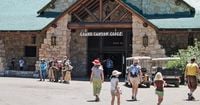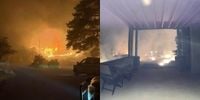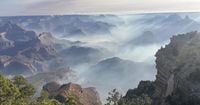On July 13, 2025, a devastating wildfire known as the Dragon Bravo Fire consumed the historic Grand Canyon Lodge on the North Rim of Grand Canyon National Park, Arizona, along with dozens of other structures. The blaze, which ignited from a lightning strike on July 4, rapidly intensified due to hot temperatures, low humidity, and strong wind gusts, forcing officials to close access to the North Rim for the entire season.
The Grand Canyon Lodge was the only lodging facility inside the park at the North Rim and was a cherished landmark for visitors and locals alike. Known for its distinctive sloped roof, massive ponderosa pine beams, and imposing limestone façade, the lodge offered guests a unique first glimpse of the Grand Canyon through the expansive windows of the famed "Sun Room." Architect Gilbert Stanley Underwood designed the lodge in 1928, and although the original structure burned down in a kitchen fire in 1932, it was rebuilt in 1937 using much of the original stonework. The lodge was designated a National Historic Landmark in 1987.
Park Superintendent Ed Keable informed residents, staff, and visitors that between 50 and 80 structures were lost to the flames. These included not only the Grand Canyon Lodge but also the visitor center, gas station, wastewater treatment plant, administrative buildings, employee housing, and numerous historic cabins scattered across the area. Thankfully, all employees and guests were safely evacuated before the fire's rapid escalation, and no injuries have been reported.
The wildfire's impact extended beyond the lodge. The destruction of the wastewater treatment plant led to the release of chlorine gas, a heavier-than-air substance that posed health risks such as blurred vision, irritation, and respiratory problems if inhaled in high concentrations. This hazardous gas settled into the lower elevations of the inner canyon, prompting the evacuation of firefighters and hikers. Rafters navigating the Colorado River were instructed to bypass Phantom Ranch, a riverside area with cabins and dormitories, to avoid exposure. Authorities also closed key trails, including the North and South Kaibab Trails and the Bright Angel Trail below Havasupai Gardens, to protect hikers from the danger.
Two wildfires have been burning near the North Rim: the Dragon Bravo Fire, which caused the lodge's destruction, and the White Sage Fire, situated about 30 miles north. The White Sage Fire has been even larger, scorching over 40,000 acres, while the Dragon Bravo Fire has consumed approximately 5,000 acres. Both fires have remained at 0% containment due to challenging conditions, including dry vegetation, strong winds, and the difficult terrain of the Kaibab Plateau.
Fire crews have been working tirelessly to contain the blazes. Over 500 personnel have been assigned to the White Sage Fire, while around 70 are battling the Dragon Bravo Fire. Despite these efforts, the White Sage Fire continues to spread rapidly, especially to the east and north, fueled by grasses and standing dead trees. Fire lines near the North Rim and the community of Jacob Lake have held, with crews using bulldozers and hand crews to create buffer zones aimed at slowing the fire's progress, particularly as it pushes downhill toward the Vermilion Cliffs area.
The North Rim was evacuated on July 10 as the wildfires approached, and the National Park Service announced that the area will remain closed to visitors for the rest of 2025. Millions of tourists annually visit Grand Canyon National Park, with the majority flocking to the more accessible South Rim. The North Rim, which is open seasonally, is known for its remoteness and quieter atmosphere, making the loss of its lodge and facilities especially poignant for longtime visitors.
Local residents and frequent visitors have expressed heartbreak over the destruction. Tim Allen, a Flagstaff resident and annual visitor, described the lodge as making one feel like a pioneer stepping back in time. "It really felt like you were in a time gone by," he said. The lodge's loss marks not only the destruction of a building but also a cultural and historical touchstone.
Aramark, the company that operated the lodge, shared their devastation but expressed relief that everyone was evacuated safely. Spokesperson Debbie Albert stated, "As stewards of some of our country’s most beloved national treasures, we are devastated by the loss." The lodge also housed valuable archives and featured a famous 600-pound bronze statue of "Brighty the Burro," a beloved symbol of the area, whose fate remains uncertain.
Arizona Governor Katie Hobbs released a heartfelt statement expressing her sorrow over the destruction and called for a comprehensive, independent investigation into the management of the Dragon Bravo Fire. She criticized the federal government's decision to manage the fire as a controlled burn during the driest and hottest part of the Arizona summer, arguing that more aggressive action should have been taken to prevent such devastation. "An incident of this magnitude demands intense oversight and scrutiny into the federal government’s emergency response," she said, emphasizing the need for accountability and improved wildfire resilience measures.
Meanwhile, in neighboring Colorado, wildfires have also wreaked havoc. Black Canyon of the Gunnison National Park, located about 260 miles southwest of Denver, was closed due to a lightning-caused fire that has burned 5.6 square miles and forced evacuations near the park. Governor Jared Polis declared a disaster for western Colorado on July 13, citing multiple fires sparked by the same storm. Another wildfire near the Colorado-Utah border, close to La Sal, Utah, has burned around 14 square miles.
The Grand Canyon's North Rim wildfire season of 2025 will be remembered as a tragic chapter in the park's history. The loss of the Grand Canyon Lodge and other historic structures underscores the growing challenges posed by increasingly severe wildfire seasons across the American West. As firefighting efforts continue and investigations proceed, the community and nation reflect on the importance of preserving these irreplaceable landmarks and the natural beauty they represent.



